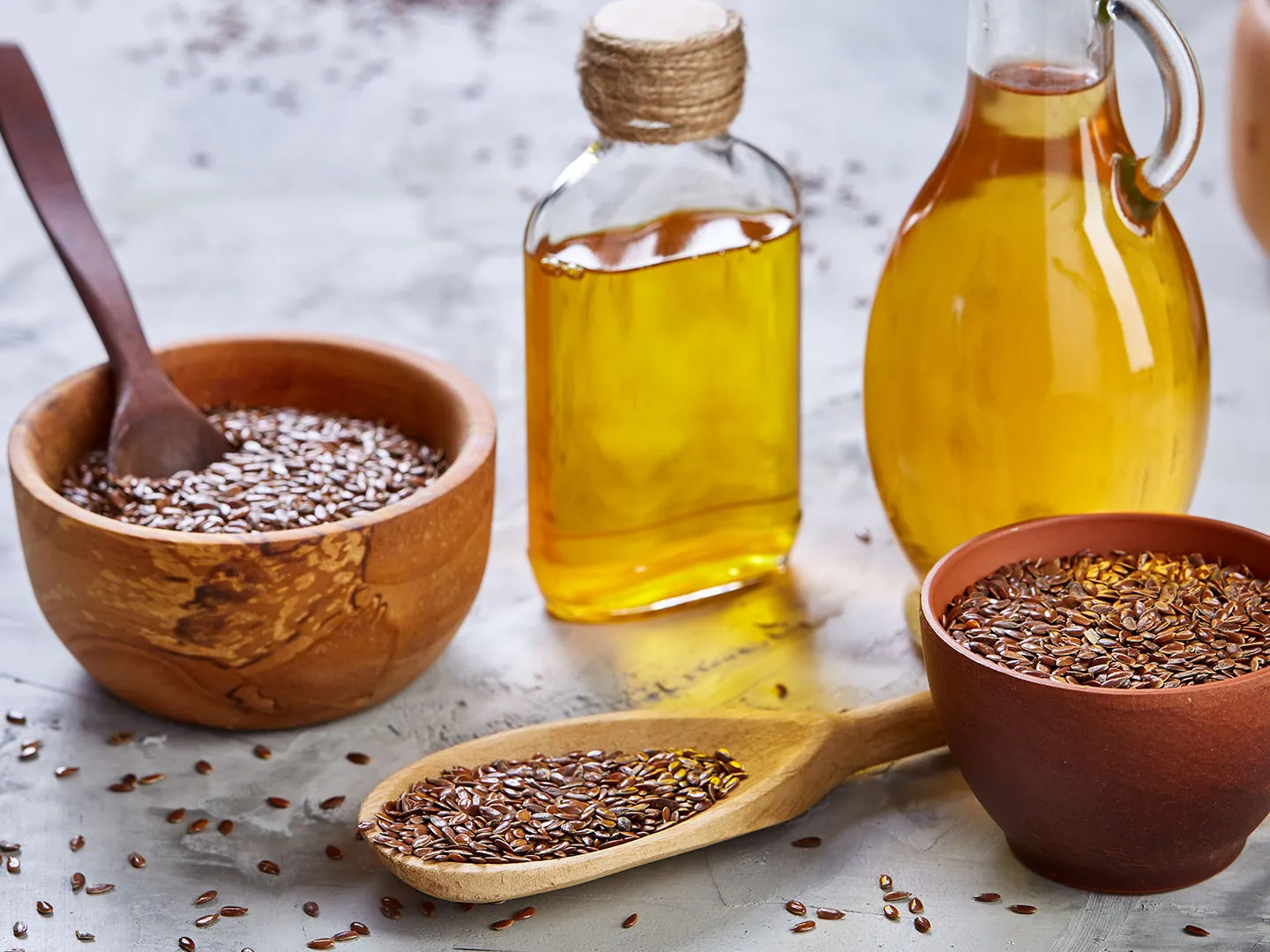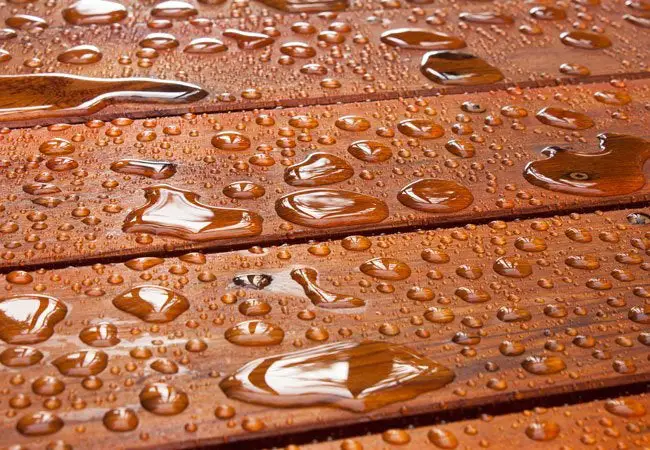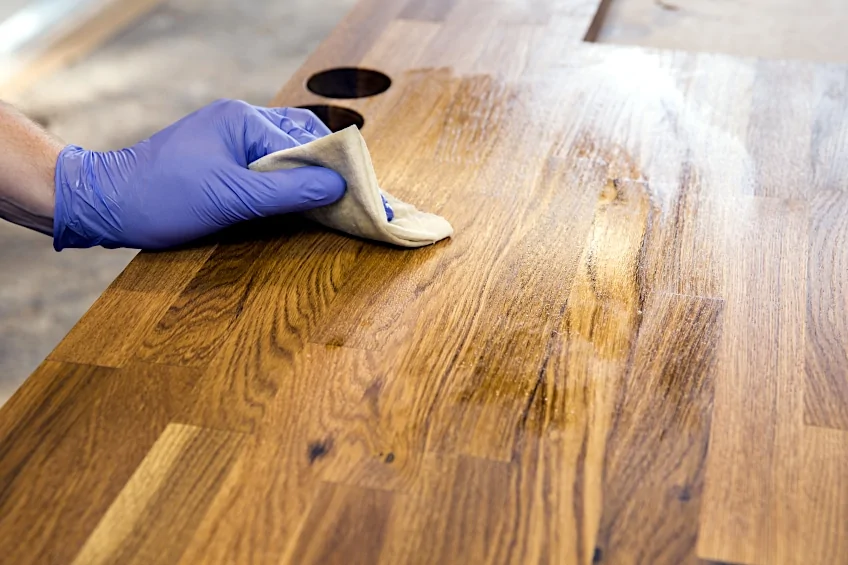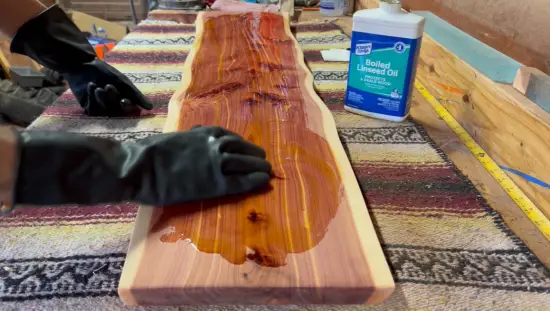A common question that I get asked quite often is whether or not linseed oil can waterproof wood. It’s a fair enough question and in this blog post, we’ll look at the answer as well as explore all of the associated details when it comes to using linseed oil for treating external timbers. We’ll look at why you might want to consider using linseed oil over other products; discuss how best to apply it, along with any safety considerations and lastly examine its environmental credentials. So if you’re in need of the lowdown on how linseed oil waterproof wood then read-on to find out more!
What is Linseed or Linseed Oil?

Linseed, also known as flaxseed, is a wonderful and versatile ingredient that has been utilized for centuries due to its countless health benefits. This superfood, which is packed with healthy Omega-3 fatty acids, fiber, and antioxidants, can benefit your digestion, skin health, and numerous other functions within the body. In addition to using linseed as a dietary supplement, people around the world have also been using linseed oil as a natural and eco-friendly product for centuries due to its unique characteristics.
This oil is derived from flax plants and is often used as a wood finish, varnish, and even in the production of linoleum. [1]
Where Does Linseed Oil Come From?
Linseed oil is a versatile and widely-used substance, but where exactly does it come from? It is derived from the seeds of the flax plant, also known as Linum usitatissimum. These seeds are rich in oil, comprising around 40% of their total weight. The process of extracting the oil involves pressing the seeds, which releases the oil and separates it from the solid components.
The resulting oil is then processed and refined, creating a clear, golden liquid that can be utilized in a wide range of applications. [2] Linseed oil has been used for centuries, dating as far back as ancient Egypt, and continues to play an important role in modern industries such as woodworking, paint production, and even nutrition. Understanding the origins of this versatile substance sheds new light on its significance and potential uses.
Types of Linseed Oil (Raw Vs Boiled Vs Polymerized)
When it comes to linseed oil, there are three main types of the product available on the market – raw, boiled, and polymerized.
Raw linseed oil is extracted straight from the seed without undergoing any additional processing. This type of oil has a short shelf life as it tends to spoil quickly once exposed to oxygen. It is also highly susceptible to mold growth and can create an unpleasant odor if left for too long.
Despite these drawbacks, raw linseed oil is incredibly popular as it offers excellent penetration into porous surfaces such as wood and provides superior protection against water damage.
Boiled linseed oil, on the other hand, undergoes a special heating process which helps improve its drying time and performance when applied to wood surfaces. This type of linseed oil also has a higher resistance to spoilage and won’t create any unpleasant odors.
Boiled linseed oil is often used as a furniture finish or protective coating, making it ideal for outdoor applications.
Finally, polymerized linseed oil is created through a process known as ‘chemical synthesis’ which combines the raw and boiled oils with special chemical additives. The resulting product provides superior protection against moisture damage while also offering increased durability over the other types of linseed oil. Additionally, polymerized linseed oil dries much faster than its counterparts, making it ideal for those looking to speed up their woodworking projects. [3]
Linseed Oil Properties

Linseed oil offers a range of unique properties and benefits that make it an excellent choice for a range of applications. It is particularly useful for woodworking projects, as the product helps protect and preserve the wood from moisture damage, insects, and UV exposure. The oil also works as a natural repellent for mold spores, helping keep your wooden furniture free from unsightly blemishes. In addition to its protective properties, linseed oil can also provide superior aesthetic appeal.
When applied to timber surfaces, it creates a warm sheen that enhances the natural beauty of the wood while also providing additional protection against water damage. [4]
How Waterproof is Linseed Oil?
Linseed oil is a highly versatile and popular wood finish that is sought after for its water-resistant properties. It is widely used for outdoor furniture or wooden decks that require frequent exposure to moisture. When applied properly, linseed oil penetrates the wood fibers and creates a protective coating that makes it highly resistant to water damage.
However, it is important to note that the level of waterproofing that can be achieved will depend on the type of wood, how many coats are applied, and the environmental conditions. In general, linseed oil provides a moderate level of waterproofing and care should still be taken to ensure long-term protection from moisture damage. [5]
When to Apply Linseed Oil
For optimal outcomes, it’s crucial to apply the linseed oil at the right time. It’s suggested to wait until the wood is fully dry before using the oil. The presence of moisture can hinder the oil’s capacity to enter and safeguard the wood.
In addition, if you plan to use the wooden item outdoors, the ideal season for applying linseed oil is during the warmer, sunnier months.
This is because the oil will cure and dry faster in warmer temperatures, and the UV rays from the sun will help to further harden and protect the wood.
How to Waterproof Wood Using Linseed Oil?

Waterproofing wood using linseed oil is a relatively simple process that can help protect the surface from water damage and other environmental factors. The following steps will guide you through the process of applying linseed oil to wooden surfaces:
- Start by cleaning the wood thoroughly with a damp cloth in order to remove any dirt, dust or debris. Once cleaned, allow the wood to dry completely before proceeding.
- Apply a thin coat of linseed oil on all sides of the wood surface using a clean cotton cloth or brush. Ensure that every part of the surface has been covered evenly with an even layer of oil.
- Let the first coat of linseed oil sit for 15 minutes before applying a second coat. This will help the oil penetrate better into the wood fibers and create an effective waterproof barrier.
- Allow the linseed oil to sit for 24 hours before wiping away any excess product with a clean cloth.
- Apply additional coats of linseed oil every few months to maintain its protective properties over time.
Following these steps will ensure that your wooden surfaces are adequately protected against water damage and remain in pristine condition for years to come. With regular maintenance, you can keep your wood looking beautiful while also increasing its longevity.
Tips for Applying Linseed Oil
When applying linseed oil, it is important to keep the following tips in mind for a successful application:
- Always wear protective gloves when handling linseed oil.
- Clean the wood thoroughly before applying any product to remove dirt, dust or debris.
- Apply the oil evenly on all sides and allow it to penetrate into the wood fibers.
- Use a clean brush or cloth for each coat of linseed oil in order to avoid contamination.
- For outdoor applications, reapply linseed oil every few months or after heavy rainstorms.
- Let the product dry completely between coats and wipe away any excess residue with a clean cloth.
To keep your wooden surfaces looking great for a long time, follow these easy steps to ensure proper protection.
Benefits of Using Linseed Oil on Wood
Linseed oil is a popular choice for wood finishing due to its unique properties and benefits. When applied properly, it can provide a variety of advantages including:
- Enhanced Aesthetic Appeal – Applied to timber surfaces, linseed oil creates a warm sheen that brings out the natural beauty of the wood while also providing additional protection against water damage.
- Increased Durability – Linseed oil helps protect wood from moisture and other environmental factors which can cause wood to rot or crack over time. This makes it an ideal product for outdoor applications such as furniture or decks. [6]
- Easily Maintained – The protective properties of linseed oil are easily maintained with regular reapplication every few months. This makes it an ideal choice for those looking for a low-maintenance wood finishing product.
- Natural Repellent – Linseed oil is also effective at repelling mold spores which helps keep wooden surfaces free from unsightly blemishes.
Overall, linseed oil is an excellent choice for wood finishing and offers a range of unique benefits that make it an attractive option for those looking to protect and preserve the beauty of their wooden surfaces.
Cons of Using Linseed Oil on Wood

Despite its many advantages, there are also some drawbacks to using linseed oil on wood surfaces. These include:
- Slow Drying Time – Linseed oil takes significantly longer to dry than other types of wood finishes, making it difficult to use in high-traffic areas such as floors or stairs.
- Messiness – The process of applying linseed oil can be quite messy due to the nature of the product and should only be attempted by experienced professionals.
- Limited Protective Properties – While linseed oil is highly effective at repelling water, it is not completely waterproof and can still be damaged if exposed to prolonged or continuous water exposure.
Overall, while linseed oil can be a great choice for waterproofing wood, it is important to consider the pros and cons before making a decision. With proper application and regular maintenance, this natural product can provide superior protection against moisture and other environmental factors for years to come.
FAQ
Does Linseed Oil Protect Wood From Rotting?
Yes, linseed oil is an effective product for protecting wood from rotting. When applied properly, it can penetrate the wood fibers and create a protective coating that repels water and other environmental factors which can cause damage over time. However, it is important to note that linseed oil is not completely waterproof and should be reapplied on a regular basis to maintain its protective properties.
Does Linseed Oil Change the Color of Wood?
Linseed oil can darken the color of wood, but it’s not a complete answer to changing the color of your wood. Depending on the type and age of the wood, linseed oil may darken it slightly or completely change its hue. As with any oil finish, applying multiple coats will cause the wood to darken more significantly. If you want to lighten or change your wood’s color, you must use an appropriate stain before applying linseed oil. The stain essentially creates a layer between the original color and the resultant darker hue from applying linseed oil. Keep in mind that using an incorrect type of stain for your project can have unintended results on its final look.
How Long Will Linseed Oil Last on Wood?

Linseed oil has been known to last for many years depending on the level of maintenance and protection provided. Regular reapplication of the product every few months will help maintain its protective properties over time and ensure that your wood surfaces remain waterproofed and in good condition. However, it is important to note that linseed oil is not a completely permanent solution and may need to be replaced after several years of use.
How many coats of linseed oil?
Typically, two to three coats of linseed oil are recommended for maximum protection. The first coat should be applied evenly and allowed to penetrate the wood fibers for at least 15 minutes before being wiped away with a clean cloth. The second coat should be applied in the same way and left to dry overnight before applying a third coat. After the final coat has dried, it is important to wipe away any excess residue with a clean cloth in order to preserve the protective qualities of the oil.
How Do You Permanently Waterproof Wood?
Permanently waterproofing wood requires using a product that is designed specifically for this purpose. There are several methods available that can be used to waterproof wood, depending on the type of material and the desired end result. One method involves applying a penetrating sealer or oil-based stain to the wood surface, which will help protect it from moisture and damage caused by water exposure.
This type of sealant will penetrate deep into the grain of the wood, creating an impenetrable barrier against moisture. Another option involves using a liquid rubber coating such as epoxy resin or polyurethane. These products create a flexible seal that is resistant to water and wear and tear. Epoxy resin is often used in marine applications, as it has superior waterproofing properties.
Finally, a hard-wearing varnish can be applied to the wood surface for an extra layer of protection from water damage. This type of finish will also help to protect the wood from dirt and UV rays. No matter which technique you use, it is important to follow the manufacturer’s directions for best results.
Is Linseed Oil Finish Waterproof?
Linseed oil can be used to make a finish on wood that is more water-resistant than an unfinished surface, but it will not be completely waterproof. Linseed oil finishes are prone to fading over time and may require regular maintenance and reapplication to keep the wood looking its best. It is important to note that linseed oil does not provide the same level of protection as modern varnishes or polyurethanes, which are water-resistant and much more durable.
Ultimately, if you need a 100% waterproof finish on your woodworking project, then using a product such as polyurethane or varnish would be the better choice. However, for projects that do not require complete waterproofing, linseed oil can still provide a great finish that is aesthetically pleasing and relatively easy to maintain.
Does linseed oil make wood harder?

Linseed oil is not a hardening agent, however it does help to protect wood from wear and tear caused by everyday use. The linseed oil penetrates into the wood fibers, helping to condition and strengthen them which reduces the risk of cracking or splitting due to stress or moisture. In addition, the coating of linseed oil acts as a barrier against water, dirt, and other particles which can cause damage over time. While it may not make wood harder in the traditional sense of the word, it can make it more resistant to environmental factors that would otherwise be detrimental.
Is Linseed Oil Toxic?
No, linseed oil is generally considered to be non-toxic. It has been used for centuries as a food additive and medicinal remedy and is still used today as a health supplement. However, it should not be ingested in large amounts or applied topically without medical supervision due to the risk of allergic reactions or skin irritation. As with any food item, consult a doctor before consumption if there are any concerns about safety.
In addition, linseed oil should not be heated as this can release toxic fumes which can be harmful to breath in. Therefore, it is best to store the oil at room temperature and avoid heating it for any purpose.
Linseed oil is generally considered safe when used correctly and has many potential benefits that could help improve overall health. However, it is important to take caution and follow instructions carefully when using linseed oil.
Is linseed oil good for outdoor wood?
Yes, linseed oil can be used on outdoor wood to help protect it from the elements. Linseed oil penetrates deep into the wood fibers, providing a water-resistant barrier that helps keep moisture out and prevents rot and decay caused by excessive moisture buildup. It also helps maintain the original color of the wood while providing an attractive sheen and protecting against dirt and UV rays. Linseed oil is relatively easy to apply and will last for many years with proper upkeep, making it a great choice for preserving outdoor wooden surfaces.
Can You Apply Linseed Oil Directly to Wood?
Yes, you can apply linseed oil directly to wood. It is a natural wood finish that provides protection and enhances the appearance of the wood. To apply it, you will need to use a clean cloth or brush and wipe it gently on the wood surface in small circular motions. Allow time for the oil to soak into the wood before wiping off any excess.
Additionally, you may need to reapply several coats of linseed oil over time as it can help maintain its protective properties and keep your wood looking good longer.
Useful Video: How to apply Linseed Oil on wood. Is it durable? Applying and testing durability. Waterproof ?
Conclusions
Linseed oil is a beneficial option for waterproofing external wooden surfaces. It is environmentally friendly, low-cost and easy to apply. If you are seeking to protect your wood from moisture damage then this could be the ideal product for you. Furthermore, it can also be used in other areas of the home, including wood floors or furniture where a natural aesthetic with outstanding protection is desired. We have taken a detailed look at how linseed oil waterproof wood and hope that the information provided has been useful to those who were unsure of its potency.
In conclusion, we suggest researching appropriate treatment times as well as looking into safety measures regarding any application procedure before commencing any work; however, if you decide that linseed oil is right the best choice for you then trust that it will provide wonderful protection against moisture damage and impart an enchanting shine! So why not give it a try today – your wood won’t regret it!
References
- https://myfavouritepastime.com/2019/07/12/what-is-flaxseed-linseed/
- https://divercitytimes.com/agriculture/crops-and-livestock/linseed-oil.php
- https://support.proudpyro.com/hc/en-us/articles/360050359373-What-is-the-difference-between-polymerized-linseed-oil-and-boiled-linseed-oil-
- https://softwoodpro.com/can-you-use-linseed-oil-on-cedar/
- https://waterprooftips.com/does-linseed-oil-waterproof-wood/
- https://livos.com/blogs/blog/why-use-linseed-oil-to-protect-wood






Leave a Reply